9 Snakes That Eat Other Snakes (Even Rattlesnakes!)
The ouroboros is an ancient symbol depicting a serpent eating its tail. It represents continual rebirth and the unity of all things. Things perpetually change in a cycle of destruction and recreation. What about the serpents that prefer the tails of other serpents? Snakes that eat other snakes are called Ophiophagus, a term that quite literally means “snake eating.” The king cobra is infamous for its diet of other snakes, but are there other snakes that like to hunt their kind? It turns out there are quite a few. Let’s take a look at 9 snakes that eat other snakes, including venomous types like the rattlesnake!
1. King Cobra (Ophiophagus hannah)
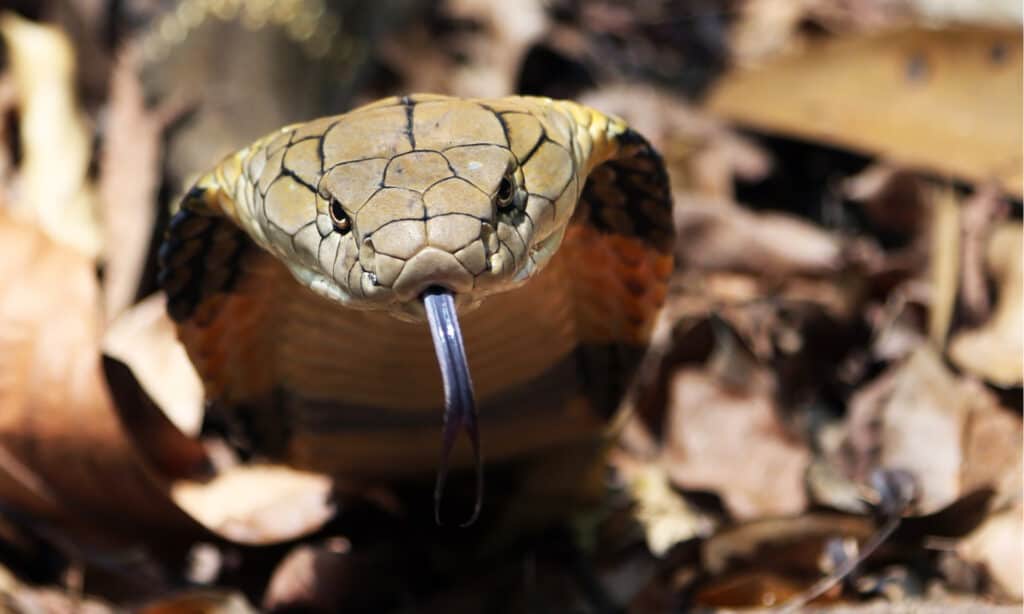
Suresh Suryasree/Shutterstock.com
King cobras are perhaps the smartest snakes in the world. They’re calculated hunters that change their hunting strategy based on the specific prey and their current circumstances. They’re able to adapt to repeated situations and recognize their handlers. They’re the longest venomous snake species at an average of 11 to 13 feet long. The largest king cobra ever found was over 18 feet long! King cobras live in southern China, India, and Southeast Asia. They enjoy streams, forests, bamboo thickets, and swamps. While these carnivorous and capable hunters typically eat other snakes, birds, and lizards, they’ll also take advantage of other prey like rodents when options are limited. As far as snake preferences, king cobras mainly eat the Asian rat snake, dhamans, and pythons. They’ll also enjoy others like Indian cobras, kraits, vipers, and wolf snakes.
2. Mussurana Snake (Clelia clelia)
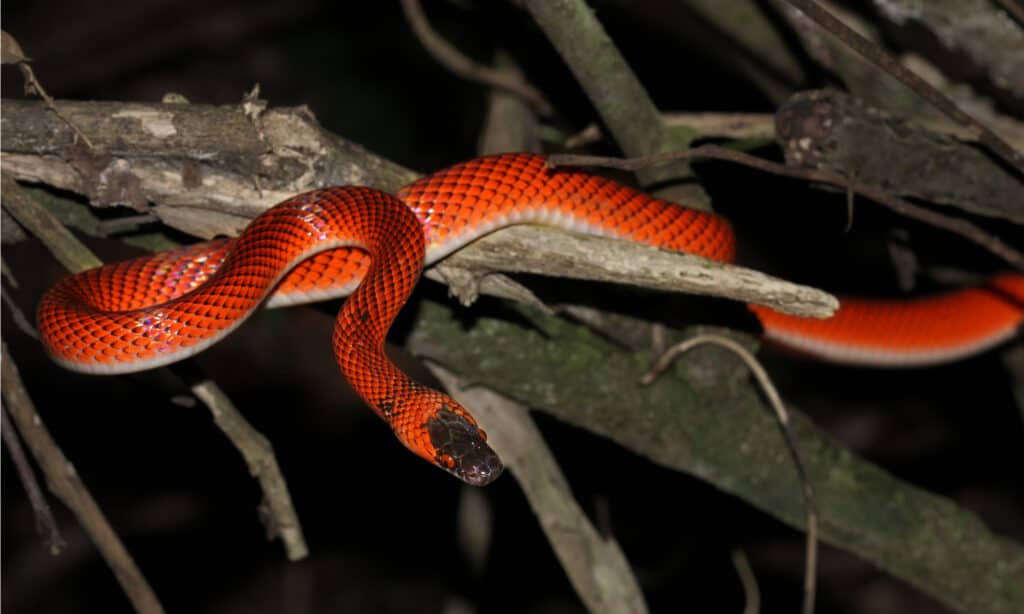
Ryan M. Bolton/Shutterstock.com
Mussurana is the name for several Colubrid species of snake-devouring snakes. They begin life as colorful juveniles and mature to be brown, gray, or black. Clelia clelia is a species that lives from Central America down to Argentina. They can grow to be nearly 7 feet long. These snakes are unique in that they’re immune to the venom of vipers as fearsome as the fer-de-lance. They prey almost exclusively on snakes, including other pit vipers like the rattlesnake.
Mussuranas use a rear-fang technique when hunting. They have teeth at the front of their upper jaws but also fangs at the rear. These are called opisthoglyphous teeth, and they help them hold snake prey by the head to subdue it before swallowing. As a mussurana swallows serpent prey, it mashes the snake so that it can fit into its narrow digestive system.
3. Common Kingsnake (Lampropeltis elapsoides)
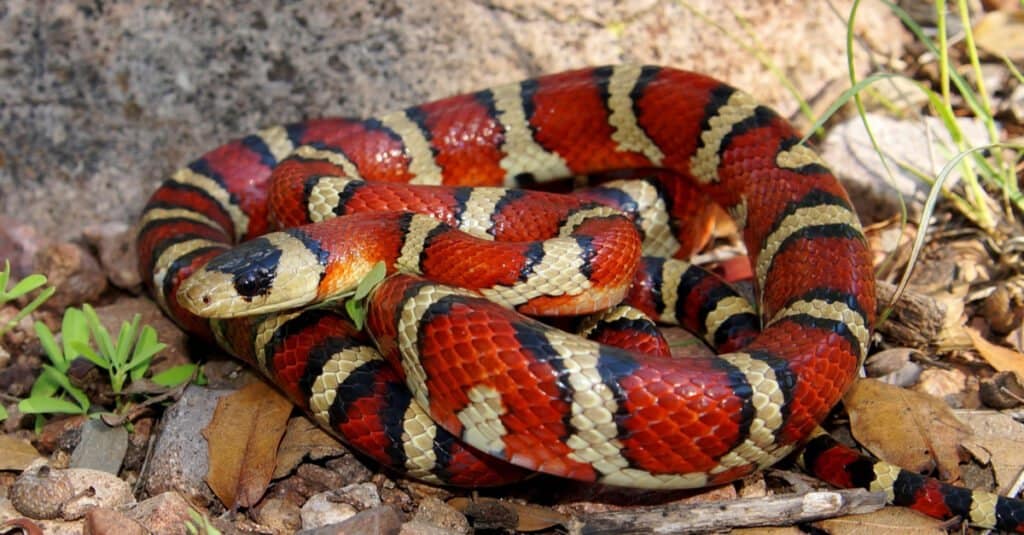
Matt Jeppson/Shutterstock.com
The common kingsnake is one of many kingsnake species which enjoy similar diets. The “king” portion of their name, like that of the king cobra, refers to its propensity to eat other snakes. These North American snakes are particularly fond of venomous species like rattlesnakes, cottonmouths, and copperheads. The venom of these snakes doesn’t affect them, so they are free to devour as they please.
Without venom, kingsnakes rely on constriction to subdue their prey. When hunting venomous snakes, kingsnakes use a special technique that lets them bite the jaws of the other snake to prevent it from fighting back. In an act of asphyxiation, the kingsnake finds its way to a victim snake’s head and starts to devour it whole while it is still alive. With its head trapped inside the kingsnake’s throat and unable to move, the other snake will die of suffocation. In addition to snakes, kingsnakes will eat frogs, turtles, birds, eggs, and rodents.
4. King Brown Snake (Pseudechis australis)
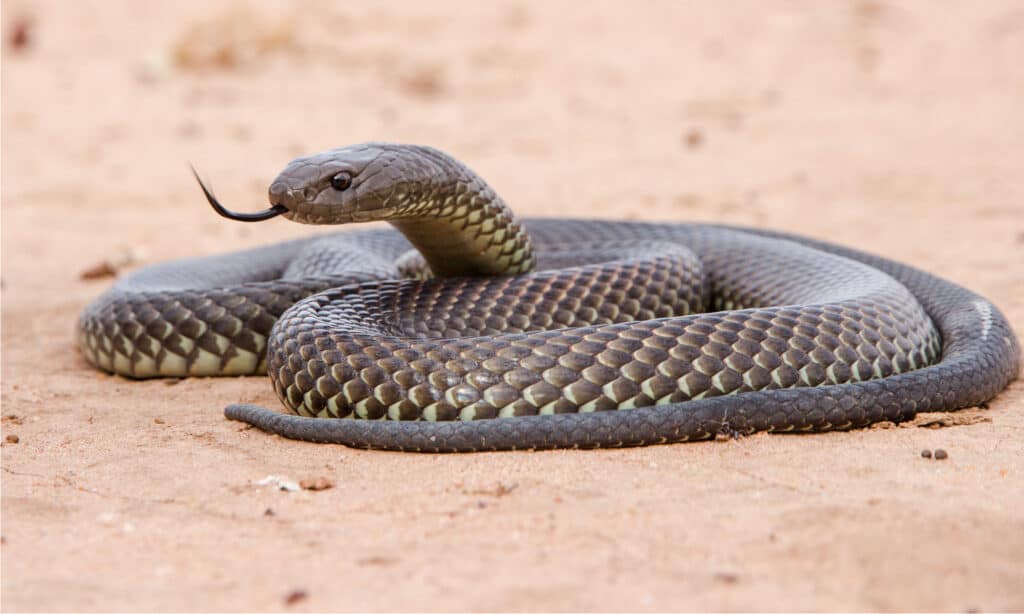
Ken Griffiths/Shutterstock.com
The king brown snakes, also known as the mulga snakes, are spread throughout Australia. These long snakes can reach up to 11 feet in length. They’re opportunistic hunters who catch a variety of prey with impressive speed. They typically bite multiple times once they catch their prey, preventing it from fighting back. In addition to snakes, king brown snakes eat birds, amphibians, small mammals, and reptiles. They eat whip snakes, brown snakes, brown tree snakes, southern shovel-nosed snakes, Gould’s hooded snakes, and crowned snakes. They’ll even eat other king brown snakes in the right circumstances.
5. Eastern Indigo Snake (Drymarchon corais couperi)

Patrick K. Campbell/Shutterstock.com
The Eastern indigo snake is a long black nonvenomous snake in the southeastern United States. It’s the longest snake native to North America, and males regularly reach 7 to 9 feet, while females tend to be shorter. Their genus name Drymarchon roughly translates to “Lord of the Forest.”
They’re members of the Colubrid family of snakes, related to kingsnakes. However, unlike kingsnakes, they aren’t constrictors and instead rely on chasing and brute force to take down prey. Once they catch prey, they’ll pin them against a hard surface and suffocate them with a strong bite. These snakes are skilled at catching up to venomous snakes and devouring them. They like to eat copperheads, cottonmouths, and rattlesnakes. They may have a resistance to rattlesnake venom that helps them to be successful predators of the venomous vipers to keep their populations in check. In addition to snakes, they’ll eat turtles, mammals, frogs, birds, lizards, and rodents.
6. Blue Malaysian Coral Snake (Calliophis bivirgatus)
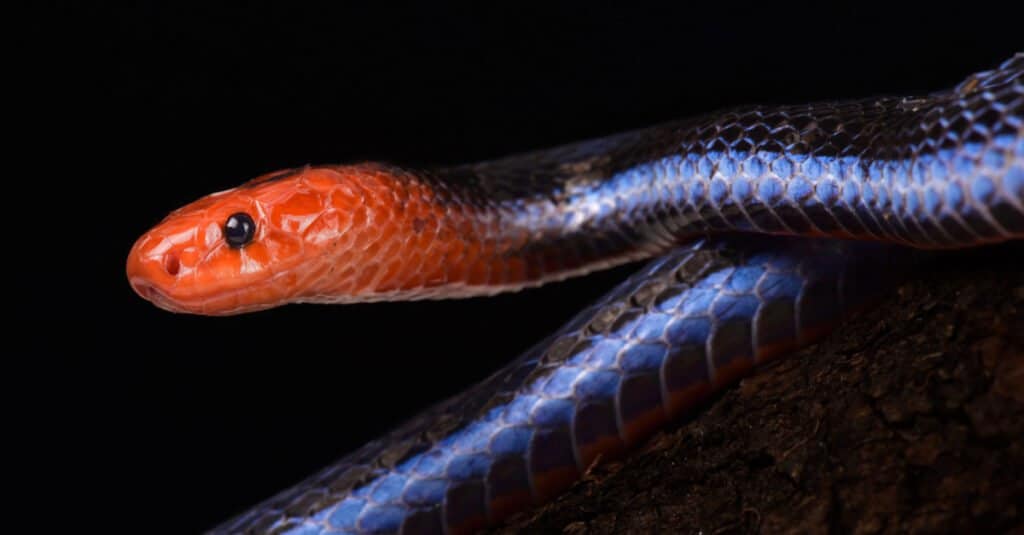
reptiles4all/Shutterstock.com
There are over 80 species of coral snakes worldwide. Most of them eat a varied diet that includes snakes occasionally, but the blue Malaysian coral snake feeds almost exclusively on other snakes. This species lives in Malaysia, Indonesia, Singapore, Thailand, Brunei, and Burma. They have a redhead, tail, belly, and a dark blue back with lighter stripes down the sides.
Blue coral snakes have a unique type of venom that is remarkable in its ability to subdue the most dangerous of snake prey. They have short fangs but long venom glands, the largest venom glands of any snake. These extend more than a quarter of their body length. Blue Malaysian coral snakes evolved a fast-acting venom that allows them to take down bigger and stronger venomous snakes quickly and avoid being bitten back. The venom doesn’t kill immediately but rather acts on all the nerves of their dangerous prey, freezing their bodies by spastic paralysis. They eat a variety of snake species and will even prey on young king cobras.
7. Banded Krait (Bungarus fasciatus)

RealityImages/Shutterstock.com
Like many other kraits, the banded krait feeds mainly on other snakes. This is a highly venomous species found on the Indian subcontinent and in Southeast Asia. It can be easily recognized by its alternate black and yellow crossbands, strong ridge, and triangular body cross-section. These carnivores will eat fish, frogs, skinks, and snake eggs, but their main prey is other snakes. They enjoy a wide range, including the Sunbeam snake, rainbow water snake, red-tailed pipe snake, Indo-Chinese rat snake, Russel’s viper, cat snake, and more. These snakes bite their victims first to inject venom and then devour them headfirst.
8. Coachwhip (Masticophis flagellum)
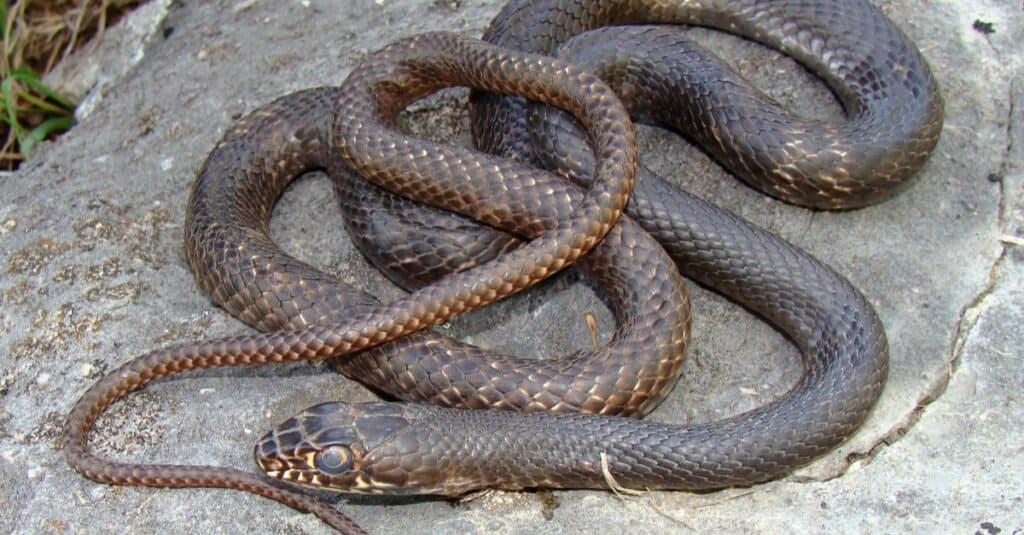
Matt Jeppson/Shutterstock.com
Coachwhips are long and slender, nonvenomous snakes native to the Americas and common in South America. They have black or dark brown coloring that lightens as it reaches the tail and a distinctive patterning that resembles a braided whip. These snakes actively search for prey and can reach speeds of up to 4 miles per hour in chase. They use neither venom nor constriction to subdue prey, instead striking out and grasping victims in their jaws. They swallow their prey dead or alive. Other snakes and lizards are their most common prey, but they also eat insects, birds, eggs, and amphibians.
9. Cottonmouth (Agkistrodon piscivorus)

jo Crebbin/Shutterstock.com
Also known as a water moccasin, the cottonmouth is a semi-aquatic venomous pit viper. It lives throughout the southeastern United States and spends most of its time in or around water. Cottonmouths have long, thick, muscular bodies that grow up to 6 feet long. These snakes have no trouble hunting on both land and water. They either chase actively or use the ambush method of sitting by and waiting for prey to pass. These carnivores eat a varied diet of fish, rodents, small mammals, amphibians, insects, and other snakes. They have also been known to eat members of their species.
Discover the “Monster” Snake 5X Bigger than an Anaconda
Every day A-Z Animals sends out some of the most incredible facts in the world from our free newsletter. Want to discover the 10 most beautiful snakes in the world, a “snake island” where you’re never more than 3 feet from danger, or a “monster” snake 5X larger than an anaconda? Then sign up right now and you’ll start receiving our daily newsletter absolutely free.
More from A-Z Animals
The ouroboros is an ancient symbol depicting a serpent eating its tail. It represents continual rebirth and the unity of all things. Things perpetually change in a cycle of destruction and recreation. What about the serpents that prefer the tails of other serpents? Snakes that eat other snakes are called Ophiophagus, a term that quite literally means “snake eating.” The king cobra is infamous for its diet of other snakes, but are there other snakes that like to hunt their kind? It turns out there are quite a few. Let’s take a look at 9 snakes that eat other snakes, including venomous types like the rattlesnake!
1. King Cobra (Ophiophagus hannah)

Suresh Suryasree/Shutterstock.com
King cobras are perhaps the smartest snakes in the world. They’re calculated hunters that change their hunting strategy based on the specific prey and their current circumstances. They’re able to adapt to repeated situations and recognize their handlers. They’re the longest venomous snake species at an average of 11 to 13 feet long. The largest king cobra ever found was over 18 feet long! King cobras live in southern China, India, and Southeast Asia. They enjoy streams, forests, bamboo thickets, and swamps. While these carnivorous and capable hunters typically eat other snakes, birds, and lizards, they’ll also take advantage of other prey like rodents when options are limited. As far as snake preferences, king cobras mainly eat the Asian rat snake, dhamans, and pythons. They’ll also enjoy others like Indian cobras, kraits, vipers, and wolf snakes.
2. Mussurana Snake (Clelia clelia)

Ryan M. Bolton/Shutterstock.com
Mussurana is the name for several Colubrid species of snake-devouring snakes. They begin life as colorful juveniles and mature to be brown, gray, or black. Clelia clelia is a species that lives from Central America down to Argentina. They can grow to be nearly 7 feet long. These snakes are unique in that they’re immune to the venom of vipers as fearsome as the fer-de-lance. They prey almost exclusively on snakes, including other pit vipers like the rattlesnake.
Mussuranas use a rear-fang technique when hunting. They have teeth at the front of their upper jaws but also fangs at the rear. These are called opisthoglyphous teeth, and they help them hold snake prey by the head to subdue it before swallowing. As a mussurana swallows serpent prey, it mashes the snake so that it can fit into its narrow digestive system.
3. Common Kingsnake (Lampropeltis elapsoides)

Matt Jeppson/Shutterstock.com
The common kingsnake is one of many kingsnake species which enjoy similar diets. The “king” portion of their name, like that of the king cobra, refers to its propensity to eat other snakes. These North American snakes are particularly fond of venomous species like rattlesnakes, cottonmouths, and copperheads. The venom of these snakes doesn’t affect them, so they are free to devour as they please.
Without venom, kingsnakes rely on constriction to subdue their prey. When hunting venomous snakes, kingsnakes use a special technique that lets them bite the jaws of the other snake to prevent it from fighting back. In an act of asphyxiation, the kingsnake finds its way to a victim snake’s head and starts to devour it whole while it is still alive. With its head trapped inside the kingsnake’s throat and unable to move, the other snake will die of suffocation. In addition to snakes, kingsnakes will eat frogs, turtles, birds, eggs, and rodents.
4. King Brown Snake (Pseudechis australis)

Ken Griffiths/Shutterstock.com
The king brown snakes, also known as the mulga snakes, are spread throughout Australia. These long snakes can reach up to 11 feet in length. They’re opportunistic hunters who catch a variety of prey with impressive speed. They typically bite multiple times once they catch their prey, preventing it from fighting back. In addition to snakes, king brown snakes eat birds, amphibians, small mammals, and reptiles. They eat whip snakes, brown snakes, brown tree snakes, southern shovel-nosed snakes, Gould’s hooded snakes, and crowned snakes. They’ll even eat other king brown snakes in the right circumstances.
5. Eastern Indigo Snake (Drymarchon corais couperi)

Patrick K. Campbell/Shutterstock.com
The Eastern indigo snake is a long black nonvenomous snake in the southeastern United States. It’s the longest snake native to North America, and males regularly reach 7 to 9 feet, while females tend to be shorter. Their genus name Drymarchon roughly translates to “Lord of the Forest.”
They’re members of the Colubrid family of snakes, related to kingsnakes. However, unlike kingsnakes, they aren’t constrictors and instead rely on chasing and brute force to take down prey. Once they catch prey, they’ll pin them against a hard surface and suffocate them with a strong bite. These snakes are skilled at catching up to venomous snakes and devouring them. They like to eat copperheads, cottonmouths, and rattlesnakes. They may have a resistance to rattlesnake venom that helps them to be successful predators of the venomous vipers to keep their populations in check. In addition to snakes, they’ll eat turtles, mammals, frogs, birds, lizards, and rodents.
6. Blue Malaysian Coral Snake (Calliophis bivirgatus)

reptiles4all/Shutterstock.com
There are over 80 species of coral snakes worldwide. Most of them eat a varied diet that includes snakes occasionally, but the blue Malaysian coral snake feeds almost exclusively on other snakes. This species lives in Malaysia, Indonesia, Singapore, Thailand, Brunei, and Burma. They have a redhead, tail, belly, and a dark blue back with lighter stripes down the sides.
Blue coral snakes have a unique type of venom that is remarkable in its ability to subdue the most dangerous of snake prey. They have short fangs but long venom glands, the largest venom glands of any snake. These extend more than a quarter of their body length. Blue Malaysian coral snakes evolved a fast-acting venom that allows them to take down bigger and stronger venomous snakes quickly and avoid being bitten back. The venom doesn’t kill immediately but rather acts on all the nerves of their dangerous prey, freezing their bodies by spastic paralysis. They eat a variety of snake species and will even prey on young king cobras.
7. Banded Krait (Bungarus fasciatus)

RealityImages/Shutterstock.com
Like many other kraits, the banded krait feeds mainly on other snakes. This is a highly venomous species found on the Indian subcontinent and in Southeast Asia. It can be easily recognized by its alternate black and yellow crossbands, strong ridge, and triangular body cross-section. These carnivores will eat fish, frogs, skinks, and snake eggs, but their main prey is other snakes. They enjoy a wide range, including the Sunbeam snake, rainbow water snake, red-tailed pipe snake, Indo-Chinese rat snake, Russel’s viper, cat snake, and more. These snakes bite their victims first to inject venom and then devour them headfirst.
8. Coachwhip (Masticophis flagellum)

Matt Jeppson/Shutterstock.com
Coachwhips are long and slender, nonvenomous snakes native to the Americas and common in South America. They have black or dark brown coloring that lightens as it reaches the tail and a distinctive patterning that resembles a braided whip. These snakes actively search for prey and can reach speeds of up to 4 miles per hour in chase. They use neither venom nor constriction to subdue prey, instead striking out and grasping victims in their jaws. They swallow their prey dead or alive. Other snakes and lizards are their most common prey, but they also eat insects, birds, eggs, and amphibians.
9. Cottonmouth (Agkistrodon piscivorus)

jo Crebbin/Shutterstock.com
Also known as a water moccasin, the cottonmouth is a semi-aquatic venomous pit viper. It lives throughout the southeastern United States and spends most of its time in or around water. Cottonmouths have long, thick, muscular bodies that grow up to 6 feet long. These snakes have no trouble hunting on both land and water. They either chase actively or use the ambush method of sitting by and waiting for prey to pass. These carnivores eat a varied diet of fish, rodents, small mammals, amphibians, insects, and other snakes. They have also been known to eat members of their species.
Discover the “Monster” Snake 5X Bigger than an Anaconda
Every day A-Z Animals sends out some of the most incredible facts in the world from our free newsletter. Want to discover the 10 most beautiful snakes in the world, a “snake island” where you’re never more than 3 feet from danger, or a “monster” snake 5X larger than an anaconda? Then sign up right now and you’ll start receiving our daily newsletter absolutely free.







